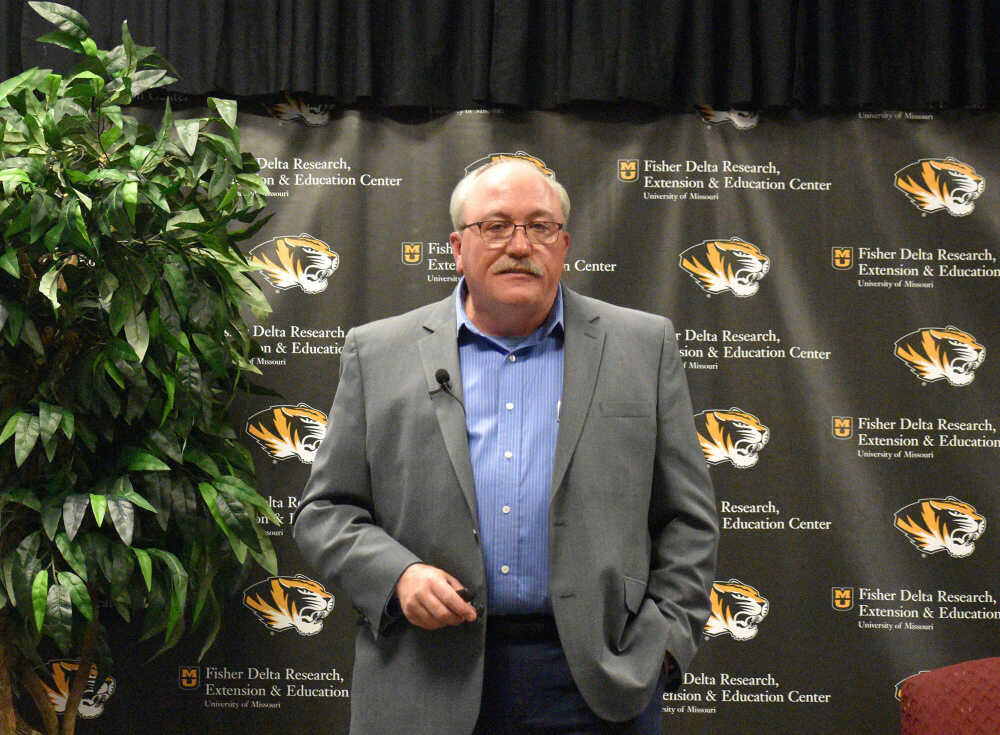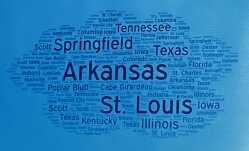
Michael White, Missouri Department of Transportation Emergency Management coordinator, speaks Thursday at the 2023 Earthquake Summit in Portageville.
DAR/Donna Farley
PORTAGEVILLE — State officials are getting closer to having models which will help direct an evacuation and disaster response effort for the region in the event of a major earthquake along the New Madrid Seismic Zone.
These models take into account surveys asking residents when, where and how they would evacuate after an incident, what roads and bridges would be most impacted and need the fastest inspections and many other factors, explained Michael White, Missouri Department of Transportation Emergency Management coordinator.
White spoke Thursday during the 2023 Earthquake Summit at Portageville. He was joined by Brandon Keller, the emergency coordinator for the Illinois Department of Transportation.
This slide from the 2023 Earthquake Summit shows where 600 Southeast Missouri residents say they would evacuate in the event of a damaging earthquake.
DAR/Donna Farley
“We’re trying to take this data and take it to the next step into a model, where we identify a system,” White said.
Southeast Missouri was the first to participate in a round of surveys asking residents to identify what they would do after a damaging earthquake, from how long they might shelter in place, to how and where they would go when leaving the region.
A second survey was recently completed in St. Louis, but with a smaller degree of response, White said.
Of the almost 900 responses from Southeast Missouri, county participants were from: 21% Cape Girardeau; 19% Butler; 11% each Dunklin, Stoddard, Scott; 9% other; and 6% each, Mississippi, New Madrid and Pemiscot.
The Southeast Missouri found that:
• 76% of respondents would evacuate after an 8.0 magnitude earthquake.
• 45% would try to shelter in their home when not asked about an 8.0 magnitude earthquake.
• 51% would check for information updates about every half hour.
• 91% would use a personal vehicle to evacuate after an 8.0.
• 35% would evacuate with 1 day; 32% within 1-3 days.
• The most likely places people would want to evacuate to would include Arkansas, St. Louis, Springfield, Texas, Tennessee and Illinois, followed by places like Poplar Bluff, Cape Girardeau, Scott County, Kentucky and other states and cities in the region.
• The preferred evacuation routes for respondents were Interstate 55, U.S. 60, U.S. 67, and highways 72, 25, 61 and 40, among others.
• 11% feel it’s very likely they’ll be impacted by an earthquake in the next 5 years; 23% said likely; and 55% said not sure.
• 79% had experienced an earthquake before.
• 2% had been injured in a previous earthquake.
• 6% had experienced property damage in a previous earthquake.
These answers are part of what the state needs to know to create models, and help anticipate when and where people will try to go after a major disaster, White said.
Other models that simulate where damage patterns would occur after specific magnitude events along different parts of the NMSZ will be incorporated with this data, he explained.
This helps build a picture of the type of resources that will be needed and where they will be needed.
Other information gathered includes the status of earthquake retrofits to existing bridges or new bridges built with earthquake preparedness as part of the design, he said.
This can help the state decide where engineers are needed the most after a major event to assess roads and bridges and open evacuation routes as quickly as possible.
Missouri enacts an assessment plan after a 5.0 magnitude earthquake to check roads and bridges, White said. Any aftershock of 5.0 or larger would restart the assessment process for each structure.
“The goal is, we’re going to get in and we’re going to do damage assessments, and make a plan for where we’re going to move people,” he said.
The plans have to include items such as how to provide fuel for people who may run out along the highway, how to help people evacuate pets, how to provide other needed services or transportation for those without their own vehicles, presenters shared.
MoDOT is currently part of the ShakeCast project, which can produce a shake map within 10 minutes of a 3.0 magnitude or greater earthquake along the NMSZ. The team is working on ways to get that out other agencies, but is currently able to get it out immediately to MoDOT engineers.
White said the hope is that within the next year a system will be in place to get it to other partners.
The ShakeCast program also includes Illinois and other states and regions.
This system is part of what helps states identify the roads and bridges that may have been the most impacted by a quake.
“It gives us a head start... pinpointing bridges that are extremely impacted,” said Keller.


